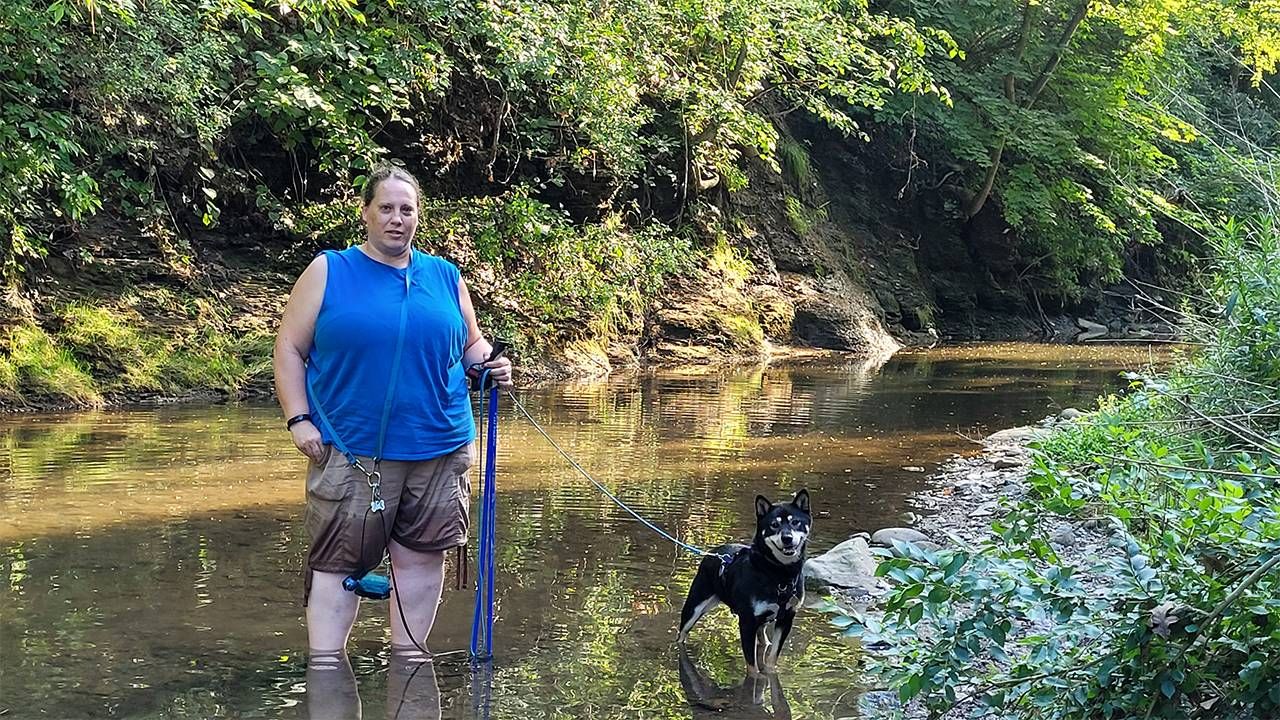What Extending the Lifespan of Dogs Could Mean for Human Aging
Researchers with the Dog Aging Project hope to unlock the secrets of human aging
As an animal care technician, Cherie Cornmesser has seen first-hand the ways that animals can help to advance medical research, sometimes leading to treatments for many conditions and diseases in humans. So, when she saw an opportunity to sign up her dog, Kylo, a 4-year-old shiba inu, for a national dog-aging study, led by the National Institutes of Health, Cornmesser didn't hesitate.

Shibas are a fairly uncommon dog breed, and the bigger pool of dogs that are included in the study, the better the potential outcomes, said Cornmesser, 51, who works with primates in a neuroscience lab at the University of Pittsburgh.
"I'm very proud of the animals I work with in the lab and am just as proud that my canine companion can also help scientists to help find answers that will lead to better outcomes and quality of life for many," she said.
The Dog Aging Project started with 10,000 dogs in late 2019, and now has almost 30,000 dogs, which researchers aim to follow for at least five years and hopefully their lifespan, said Kate Creevy, the project's chief veterinary officer and associate professor in the Department of Small Animal Clinical Sciences at Texas A&M University.
Hopefully, some of the answers from the canine companions will help extend and improve their human owners' lives.
The research is the largest study of companion dogs ever performed, and investigators are looking for more dog owners to volunteer.
The goal is to understand why some dogs — like some people — age well, and why other dogs — like other people — age poorly, Creevy said. Dogs live shorter lives than their humans, with smaller breeds living up to 18 years.
What's interesting, Creevy said, is that larger dogs have a short time as a puppy, grow into adulthood more quickly and spend more time as a senior. Small dogs stay in that healthy middle age window for a longer time. Researchers just aren't sure why.
But hopefully, some of the answers from the canine companions will help extend and improve their human owners' lives as well.
What Researchers Want to Know
Volunteers answer extensive surveys of 300 to 400 questions about their dog's life, from where they sleep to how much they sleep, what kind of toys they play with, how much and what kind of food they eat and how many times a day. Researchers follow up at least once a year for the rest of the dog's life.

"Sometimes dogs are fed one time a day, or sometimes it's three times or the food is left out all day. There's everything in between, and we're looking to see what shape they're in and study what's different among the dogs and how their life unfolds," said Creevy.
"It's not that different from human aging and intermittent fasting, and looking at the dogs who are fed once a day — is there any benefit versus the dogs who are fed three meals a day."
Researchers aren't just looking at one thing across the study. They may look at a particular disease across one breed or aging across a particular size of dog.
One of the areas of focus is called the "body condition score." It's kind of like the body mass index or BMI for dogs. It's a score of 1 to 9 that all veterinarians use to rank all breeds of dogs based on size, 1 being the skinniest and 9 being the fattest.
Researchers are looking at whether an animal's body condition score is related to its lifespan and whether, like studies in fruit flies and mice, leaner species live longer.
Some Dogs Will Be Enrolled in a Drug Trial
Another area of interest is the drug Rapamycin, an immunosuppressant medication used in people to prevent organ rejection in transplant patients (interestingly, it was originally found in a soil sample at Easter Island.) At low doses, the drug has been found to have anti-aging properties and prevent obesity.
This isn't a clinical trial where the dogs are in a lab. They are living in our homes, sometimes eating our food, drinking the same water and exposed to the same environmental risks.
As part of the Dog Aging Project, several hundred dogs are part of a clinical trial where some receive a very low dose of the drug and others receive a placebo. Scientists are looking to see if Rapamycin changes the dogs' metabolism in a way that resembles caloric restriction.
In similar rodent studies, mice retained muscle mass and cognitive function, but at a cellular level they experienced the anti-aging benefits typically gained from restricting calories, said Creevy.
During the first pilot study testing Rapamycin in dogs, there was a small but noticeable improvement to the animals' heart function. But the second study at a lower dose did not produce the same results.
Now, researchers are working on a third study on a larger sample of dogs using a low-dose model similar to the first round that would treat the dogs for one year and then follow them for two more.
The anti-aging benefits of Rapamycin are well known, but the drug has some serious side effects in humans at higher doses. It is currently being studied in humans to treat different kinds of cancer and was suggested as a treatment for COVID-19 as well.
"We get requests from people (who want to take the drug) to prescribe it to their dogs all the time, and we say no," said Creevy. "But there are definitely people who have chosen to take it."
Other Research Goals
There are many aspects to the Dog Aging Project that excite researchers.
First, there's the number of animals involved, and although older dogs like Kylo can take part, there is the opportunity to follow dogs across their lifetime. All the raw data will be made public to the research community as well, said Creevy.
"That creates so many opportunities — people will be asking questions of the data that we haven't thought about," she said.
But the key point of this study that most excites Creevy is that this isn't a clinical trial where the dogs are in a lab. They are very much a reflection of their owners and of our lives, at this point in time. The dogs are living in our homes, sometimes eating our food, drinking the same water and exposed to the same environmental risks.
"All of those things have impacts on their health, and our health," Creevy said.
One aspect researchers are really looking at is exercise. Some studies have found that people who exercise have dogs who exercise. And researchers are looking to see how dogs do when they exercise five days a week versus two days a week, plus what impact that has on the dog's health.
"If I don't go for a run, it's not like my dog can hop in the car and take himself for a run at the dog park," Creevy said. "But people who like hiking or biking tend to choose the kind of dogs who can go with them."
The study fully launched in late 2020, just as the pandemic was starting, and researchers are now doing their annual follow-up to see what happened over the year. Anecdotally, a lot of people said that because they were home so much, both they and their dogs got out a lot more.
Cornmesser, the animal technician whose dog Kylo is part of the survey, said her routine is to go for a mile or two walk every day, and that during the pandemic, she was seeing a lot more of her neighbors outside.
"There was a dramatic uptick in the number of people who had dogs that I didn't know … had dogs," she said.
To nominate your dog for the project, fill out this survey.


